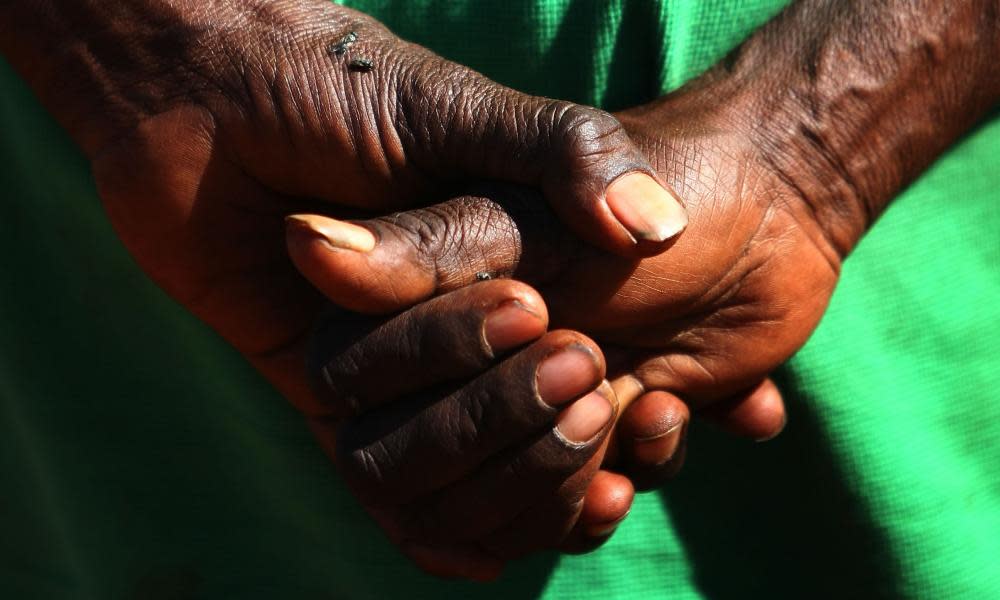'Lack of money': 43% of Aboriginal people in remote communities have gone without food in past year

A national inquiry into food security in remote Aboriginal communities has heard that poverty is the single greatest contributor to food insecurity, and that raising income is essential to stop people going hungry.
The inquiry heard that in 2019, 26% of Indigenous people nationally lived in a household which, in the previous 12 months, had run out of food and could not afford to buy more.
In remote communities, the national Aboriginal and Torres Strait Islander health survey (NATSIHS) found, 43% of Indigenous people reported having gone without food in the previous 12 months.
Several submissions reported stark price differences between remote stores and those in regional and urban centres.
Related: Remote communities going without essentials amid lockdown, NT groups say
The Australian Council of Social Service’s 2019 survey showed that basic goods in remote stores are 56% more expensive than at regional supermarkets. There were also big price differences between communities – with a basket costing $1,150 in one privately owned store, and $680 in a store run by a community group.
At Kowanyama in far north Queensland the shire council reported that a lack of competition kept prices high.
“Meat is very overpriced with regular mince costing approximately $18 per kilo and beef rump steak approximately $20 and above for 500 grams,” Kowanyama Shire’s acting CEO, Katherine Wiggins, said.
“We have received reports from residents that baby formula can cost $50 per 900 grams. We have also received reports from residents that nappies can cost $50 per packet,” Wiggins said.
At Pipalyatjara in remote South Australia, the art centre managers said that before the increase in jobseeker payments, community members lived on “$200 to $400 per week, which is often spread across families”.
Ninuku Arts Centre managers, Mandi King and Lisa Phillips, did a shop “of basic dairy, non-perishables, and cooking supplies at the lowest prices” at their local store, and at a supermarket in Alice Springs. The cart in Pipalyatjara cost $118, while the Alice Springs shop cost $85.
“It is our strong opinion that unless buying and pricing systems are either further subsidised or overhauled for food and consumables for remote communities, or all Centrelink payments for Indigenous peoples in remote communities are permanently raised, the conditions of poverty are nearly inescapable for most people here.”
Dr Francis Markham and Dr Sean Kerins of the Centre for Aboriginal Economic policy research (CAEPR) at the Australian National University said in remote areas food insecurity is becoming more prevalent.
“We urge the committee to face the reality that the greatest barrier facing residents in remote communities from having reliable access to affordable fresh and healthy food, groceries and other essential supplies is poverty. It is not a lack of food in communities which is the primary cause of food insecurity; it is a lack of money.”
“If food prices in remote areas were able to be brought into line with those in cities, then the proportion of households running out of food in remote areas might fall by around 10 percentage points,” Markham and Kerins wrote in the CAEPR submission.
They suggest introducing price controls and providing remote store subsidies to keep prices on par with the rest of Australia, but point out that incomes in remote Indigenous communities need to be increased “to a liveable standard”.
“This is necessary because although food prices in remote locations may be reduced somewhat, they will necessarily remain high for structural reasons.
“Prior to the introduction of the temporary coronavirus supplement, poverty rates in remote Indigenous communities were above 50% and rising,” they said.
They also called for government support for social enterprises that undertake food provisioning and economic development, and support Aboriginal people to travel to homelands and outstations where food provisioning is easier.
The Australian Competition and Consumer Commission (ACCC) told the inquiry it had examined a number of complaints regarding excessive pricing, but “has yet to uncover any evidence of conduct that could be said to be misleading or deceptive or unconscionable”.
“Rather, in its assessment of specific pricing complaints, the ACCC has found that high retail prices are generally reflective of the high cost of goods to the community store, and are not indicative of community stores increasing profit margins.
“The ACCC will continue to consider all complaints and enquiries on a case-by-case basis and will not hesitate to take action in the event that it finds evidence that a community store is making false or misleading representations to consumers, or charging excessive prices in an unconscionable manner.”
ANU emeritus professor Jon Altman said food security in remote communities “improved markedly during the pandemic” with the introduction of the one-off economic support payment of $750 from late March and the coronavirus supplement of $550 per fortnight from late April.
“On top of this, and despite early opposition from Minister Wyatt, social distancing requirements saw the cessation from March 2020 of onerous mutual obligation requirements for those on the Community Development Program [which] liberated Indigenous people to return to homelands and participate in self-provisioning without risk of poverty-deepening penalties for breaching,” Altman said.
“People report more income, more purchase of food, less hunger and less stress about having enough income for shopping.”
The inquiry, by the House of Representatives standing committee on Indigenous affairs led by Liberal MP Julian Leeser, is due to report in October.
Leeser said it’s important that people in Indigenous communities have reliable access to food that is reasonably priced.
“There have been significant reports of very high food and grocery prices in remote communities and issues around the secure supply of fresh food,” said Leeser.
“The inquiry will look at the situation in remote Indigenous communities, and the effect of supply chains and local businesses on the cost of food. The inquiry will also look at the role of regulators in dealing with the situation.”

 Yahoo News
Yahoo News 
